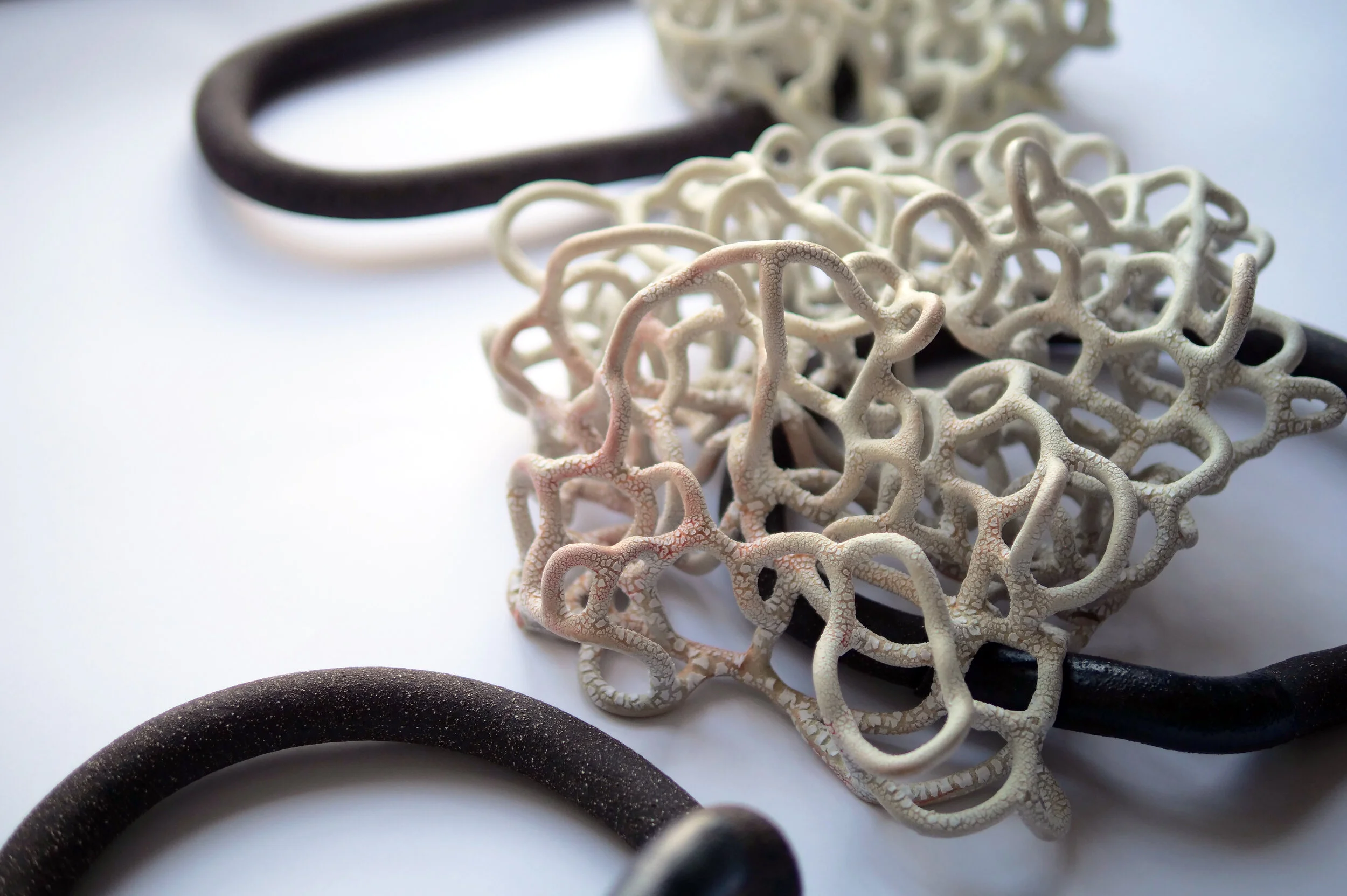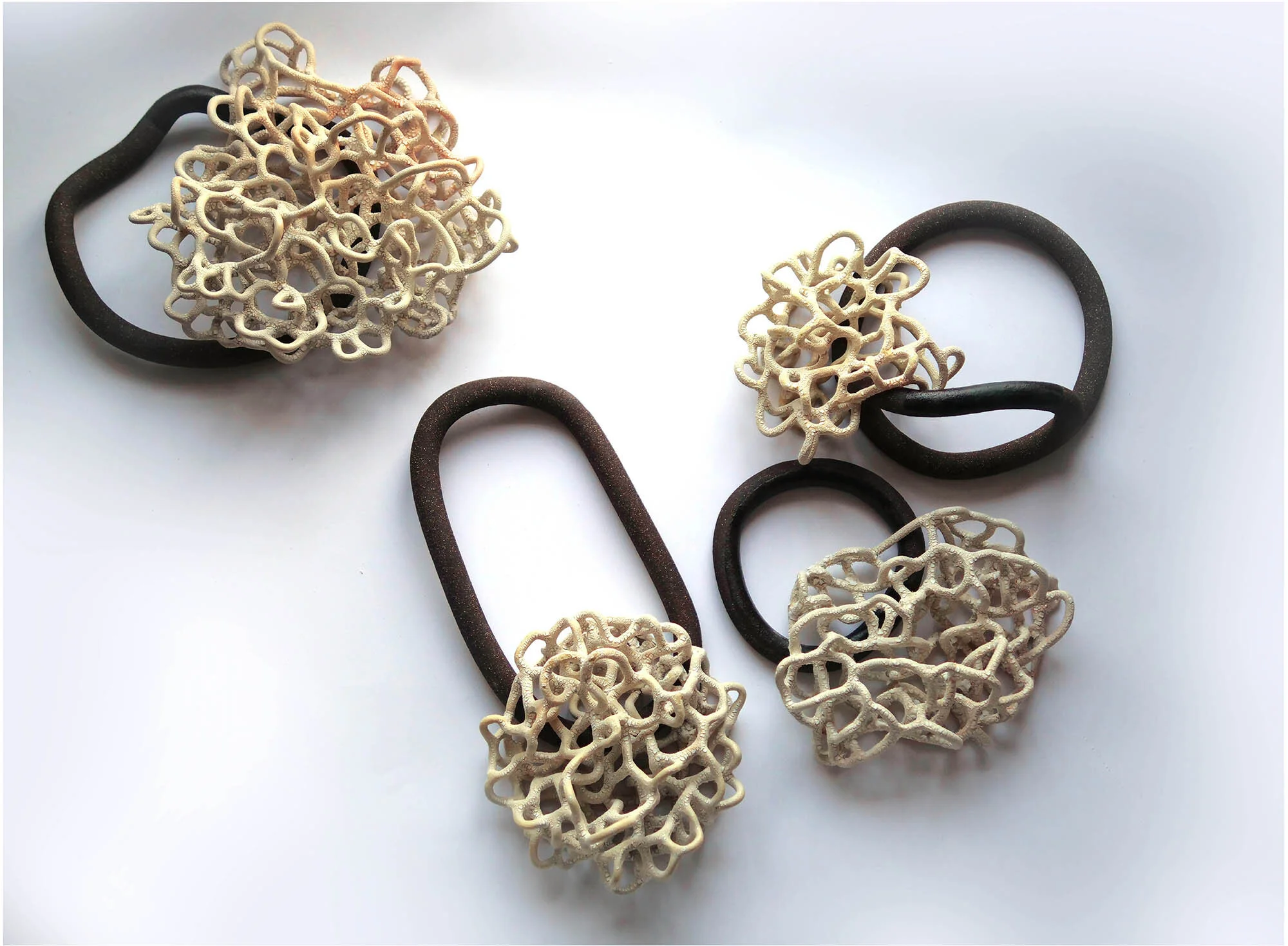COLETTE VERMEULEN & DIANA BUTUCARIU
GEOMETRY AND FORM
Colette Vermeulen works with paper collages and creates sculpture from recycled paper pulp and screen-printing methods. She finds that the material allows her to express herself in an instinctual kind of way, moulding in the form a certain essence of feeling
or reflection in any given day.
Hot Spring
Lake
Vermeulen explains how she enjoys raw, unrefined base materials,
and doesn’t mask their texture in the final products. In her pieces you can see the layers and texture of paper’s history, also like fossils captured in rocks. She intentionally
keeps a strong sense of the manual labour that went into them,
and the artisanal aspect of the design.
Vermeulen’s design journey began with a successful career in fashion,
but after five years of working in London she moved to Berlin to pursue a career in design under her own name. However, it was a trip to America that really shifted
her direction as a maker.
Wave
“All my pieces have in some way to do with nature. Not necessarily
in the most direct sense anymore (in the case of the landscapes
that I started off with) but more in terms of our natural forces in our bodies, our connection and disconnection from nature and natural rhythms,
our gut feelings or intuition. I always try to show
a certain current, or movement.”
The pieces by Vermeulen that are included in the Cluster Crafts online exhibition and Online shop are named Ripple, Wave, Hot Spring,
Lake and Flash. All of them are natural phenomena,
which can also represent certain feelings or emotions in the body or mind.
She took a chance on a change of creative direction and left the UK to take up an artist residency at the Frank Lloyd Wright School of Architecture in Taliesin West.
The landscape of the Arizonian Desert got under her skin, and she began to sketch
the endless horizon on scraps of paper. She then began to develop ways of building
3D sculptures out of recycled paper pulp. She began by making collages
that represented the immensity of the colours of the sunsets and moonrises.
Ripple
“The piece Flash is the first paper pulp piece I ever made
which has multiple colours. It was a bit tricky to achieve but I am excited about the result as it is very dynamic.”
Many of Vermeulen’s pieces are inspired also by architectural forms
and geometric shapes, which she then abstracts to a point
where they also seem to mimic nature and the flesh.
Vermeulen hopes that in the shapes and movement her material,
viewers may be left with the space to see their own echoes -
faces or reflections of memories of other forms.
“They are a translation of energy, emotion, a mood or atmosphere that cannot be expressed with language,
only be communicated by experiencing the visual,” she explains. “Shapes like circles and waves always keep coming back, because they represent a certain balance or dis-balance, or movement.
I like to see my object as a sort of totem, objects that have a certain energy or message.”
In her regular work, Vermeulen uses a lot of colour in her work as a means of translating the energy in the pieces. However, she explains that her paper sculptures are slightly more muted in tone; quieter work,
where there is a stronger focus on the texture, shape and materiality.
Flash
Colette 03
“I love how accessible paper is as a material, how much there is around us which can be recycled infinitely. The sculptures became a bigger part of my practice since during the Lockdowns I kept finding more
and more cardboard boxes everywhere from the stuff people
were ordering online” says Vermeulen. “I also love that I can use my own trash and leftovers from my work. The small bits of paper which are left over from making paper collages, I shred in a confetti machine,
and I turn it into pulp for the sculptures.”
Also working with geometric forms and energetic shapes,
Hungarian artist Diana Butucariu works with clay and glass to create
3-dimensional sculptures with unusual webs of movement.
Dark Blue Templum
Currently based in Stockholm, Sweden,
Butucariu has a multi-disciplinary approach to making, often collaborating with other artists and designers,
or mixing materials and methods. She has worked with musicians, programmers, animators and more,
all of whom have shown her how her artistic work
can be part of a greater context of expression.
Butucariu grew up in a family with an artistic heritage
and found that design came to her almost
like second nature.
Dark Blue Templum
Mossy Crowd
“I grew up with a father who is a glass artist, and I was working with him in the studio from a young age,”
she explains. “In high school I started learning ceramics as my speciality in art school.
I have always felt that I need shapes and volumes to express my ideas. The ceramics material allows me to do
that and much more, so it was an easy pick.”
Butucariu aims to create work that captures in the stillness of the finished objects a strong sense
of the movement in life. She also hopes the pieces stimulate conversations around culture and tradition.
The pieces included in the Cluster Crafts online exhibition and Online Shop are part of a collection
made in the summer and autumn of 2020.
Open
“As it probably felt for everybody, 2020 was a difficult and challenging year. Many times in the last year I had to cancel trips to the studio
and stay home and put my thoughts only on paper,” explains Butucariu. “This was useful in two ways. I became more aware of how precious
the time in the studio actually is and I also had time to analyse in detail all the steps in the creation process before I started working in clay,
and so could speed up later while making the pieces.
It made me work efficiently.
“I see these pieces as small victories; they survived a very fast making process and defeated the circumstances.”
Arches
Butucariu enjoys working with ceramics because of the way
if responsibility to the touch and how it can be pushed to the boundaries of what is possible.
“Ceramics is a material with endless possibilities in every step
of the making process,” she says. “I often like to introduce additions
to the clay bodies; this gives the materials I'm working with interesting structures. You can see structures in the glazes, in the clay bodies
or in the shapes of my works. The balance between shapes and textures is vital for me and something that preoccupied my thoughts
while working with these pieces.”
The inspiration for each piece tends to begin
with nature or looking at the human species or condition.
“I view my works as creatures who can move but prefer to stay in a stop motion hibernation mode,” she says.
“I like to think that they invite the viewer to a dialogue, about identity and culture, traditions and social norms.
I see art as an instrument that each person handles differently. The artist is offering the instrument,
and hopefully it is a useful one.”
Arches
Thank you for reading,
Katie De Klee & Cluster Team.






